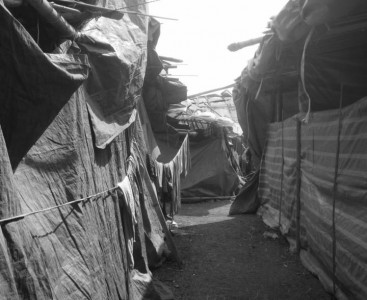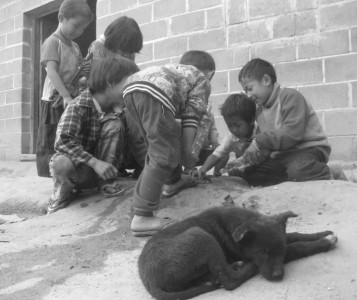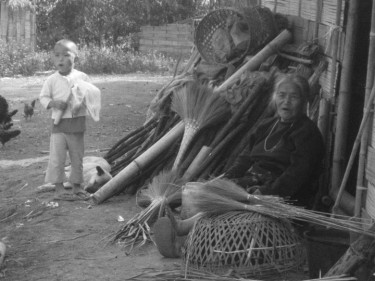This post is part of our special coverage on Refugees.
Nine months have passed since clashes broke out between the Myanmar Army and Kachin Independence Organization (KIO). Thousands of people have fled to refugee camps in other areas in Kachin State, and in villages near China's border.
At least 66 refugees camps have been set-up in government-controlled areas, while others are in Kachin Independence controlled areas and on the China side of the border.
Based in Yangon, Burmese blogger Nang Nyi and her friends visited one of those refugee camps near the China border in mid-February, and she wrote about her experience there. In part one of her blog entry, she started her story by saying:
As everyone know, I am just a normal girl. I do not get involve in politics, nor do I understand it, and I don't hold onto or participate in any parties or organizations or any ideology. I only believe in freedom, justice, and humanitarianism. So I would like to share back my experience in the way I've seen it and I've felt it.
There were four other friends who went along on the trip with her. They travelled from Yangon to Mandalay and then to Muse, in Shan State. They then crossed over to Chinese's border town of Shwe Li to buy the necessary things for the refugees. The next day, they went to the refugee camp:

Map of the Trip Made by Nang Nyi and her Friends
When war broke in Kachin State, refugees ran away to the nearest border to escape. Loizer Refugee Camp is a well-known camp. But the refugee camps we went to were at the borders near Lwe Je. The camps are in the Chinese area of Lai Yin, next to Lwe Je. The refugee camps near Lai Yin were managed by a Kachin group called Wunpawng Ninghtoi (WPN). “Wunpaung” in Kachin means “All Kachins”, and “Ninghtoi” means “Light”. So you can say that this group is the “Light of Kachins”.
When she entered the refugee camp, she saw many kids, but the kids seemed to be afraid of her:

A Kachin Kid (Photo by Nang Nyi)
I have volunteered at orphanages and monastic education centres, so I was used to being delighted at seeing the kids and greeting them enthusiastically. But here, we can not get near these kids. We were sad to see that kids ran away from us because we were unfamiliar faces and our looks showed that we were Bamar.
She also commented about the conditions of the refugee camp:

Tents at the Refugee Camp (Photo by Nang Nyi)
One thing we faced when we got there was (not having enough) toilets. In a refugee camp that had over 1000 people, they only had 11 toilets. The water for the toilet has to be retrieved from an almost-dry stream over a mile away. In the whole camp, there was one well. They use that water for drinking. The camp was built on an old dump site between the sugarcane fields at the outskirts of a Chinese village.There were no big trees around the area, so during day time, it was dusty and hot air blew. At night, the cold winter wind passed through the waterproof canvases and gets very chilly.
In part two of her blog entry, she wrote about visiting old mills, or coal factories to find out about their needs. She wrote more about that in her post:

Kids Playing at the Refugee Camp (Photo by Nang Nyi)
Some of the camps that they lived in are very near to the places where the fightings were going on. We also got to a place where they said over a field of corn and a field of sugarcanes, they'll be back to their old village. At such camps, they go back to their old villages to get drinking water. They had to watch out for the situation, and avoid the gunfights. On the morning that we were leaving, a man who went to harvest sugarcanes in a sugarcane field died of a bomb explosion. Also, many people have died in those camps because of diarrhea.
On the second day of her trip, they and the responsible people from the camp held a small meeting to discuss about what the refugees needed, and what they can give back in return:

This Woman Sells Brooms and Sell them at Chinese Markets (Photo by Nang Nyi)
The main things that they need are drinking water, water for cooking, and toilets. After that, medicines, and then foodstuff. Clothes, kitchen items, blankets and pillows are sufficient due to donations from the Chinese villages. But what they gave us were sweaters and pants, so they still need longyis for the women. So we immediately donated the left-over money so that they can dig a well there.
In part three of her entry, Nang Nyi wrote about the terrible ordeals that the Kachin villagers faced:
One evening, the (Burmese) army came to the place where the villagers were hiding, and started shooting at them. The villagers grabbed their children who were playing near the village and stream, and tried to run away, but a woman who had just given birth, her new seven-days-old child, a 4-year-old kid, and her mother were left at the village.
The villagers who were hiding in th forests heard the children crying all night, but they dared not go back into the village. So they didn't run very far away, and waited all night. Only after the soldiers left in early morning, the father of the 7-day-old-child, and the grandfather of the 4-year-old kid went back to look. The two kids couldn't make a sound anymore due to crying all night. The corpse of the mother of 7-day-old child, who had an bayonet wound from left rib to right rib, was found under a rock. The villagers were not able to take her with them, nor bury her, so they just carried the kids, and left. The mother of the 4-year-old kid was abducted by the soldiers, and haven't heard since.
She also wrote about what a Kachin villager had told them during the meeting:

A note written by a Kachin refugee, which says: "We all love you. When you go back to Yangon, will you give us your phone number? When you get back to Yangon, will you send us our photos? We all love you"
“I am so happy that the Bamar kids are visiting us. We do love the Bamar people. After all, we are all human, so we ‘re happy and thankful that you came and helped us in anyway you can. This is not because of how much you donated us, but because of your kind hearts. We are happy that you will be helping us with the things we need, but what we really need are not those. We want peace. We want to go home. We want to live peaceful in our own farm, in our own land, and in our own home with our families. So please help us for that.” – the villager told us with tears in his eyes.
When Nang Nyi and her friends left the camp, the villagers came along with them to their car. She wrote about their farewell message:

A Group Photo of the Villagers at the Refugee Camp (Photo by Nang Nyi)
We told them, “We will see you again, but not here. In Kachin State.” They cried when they heard that. They replied, “Yes, we also want to see you again, but not here. We will meet you in our own villages”.
The fulfillment of the wishes of the Kachin refugees may not be too far away. Delegates of the KIO Army and representatives of the Burmese government will be meeting in Ruili for the third round of talks for ceasefire negotiation this week. Before departing for Ruili, Sumlut Gam, Head of the Kachin delegates, said:
I'm optimistic. Everything will be better.”
This post is part of our special coverage on Refugees.







2 comments
I hope that with all the change happening in Burma right now that life will improve for the ethnic minorities and all the refugees. I’ve not been to these Kachin camps but they do remind me of the Karen refugee camp I visited in Thailand. The camp was too full and the Thai authorities, fed up by the constant stream of refugees, would not allow new unregistered refugees from getting food rations, so the registered refugees had to share theirs.